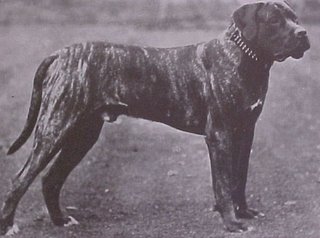Moseley & Training

Part II of a post by Dan Balderson regarding Moseley and Burton
Moseley's program was based predominantly on police dog style training. He also bred purebred mastiffs and was involved with other breeds, including the GSD/Alsation, which was still only ever found in the UK as a police dog at that time. He never directly made use of Bull Terrier or Boarhound/Suliot/Ulmer/Great Dane blood or Bloodhound. In fact, he abhorred it and tried to keep his dogs much smaller. He found dogs over 27" tall lost too much quickness and agility, plus carried too much size for the best endurance and ability to use their bodies to overpower a man. It was Moseley who largely eliminated these other breeds from the BM, but also he who was strongly involved in developing the fawn/fallow-smut dogs with black masks, clearly demonstrating that he did make use of the more modern version of Mastiffs and Bulldogs. His 'recipe' was well documented as being 60:40 Mastiff:Bull, though his percentages are not exactly scientifically correct by modern standards.
As for training, these dogs were trained in Gamekeeping and Police dog trials that pretty much set the tone for modern sport as people know it today. This included suit work, extensive use of muzzle work, relatively little if any sleeve work, agility, and OB. They commonly competed with the standard set by the much smaller Airedales, and dogs from the likes of Burton were more highly esteemed than the continental shepherds by those who could obtain them, right up until the 1920's, when the lines essentially died-out due to social/political change and the wars, which destroyed the Gamekeeping and working Mastiff populations of the UK, a terrible shame.
The agility and OB included scaling walls and many of the tests still found in the KNPV such as the ability to jump a ditch/navigate and retrieve a stream/river using gun dog style commands for send-aways. Scale walls, stone walls, and hurdles were all used, as were gates and hedge jumps. Unlike modern sports that are patterned, you would not really know what exactly you would encounter, just have an idea. OB routines like modern WT today were not conducted in manicured rings, but instead could see you being directed into all manner of terrain; long grass, trees, water, toward people shooting shotguns, etc. Environmental soundness around firearms, livestock, and non-threatening people would all have been tested.
Directional control was also prominent, and conducted in similar ways to gundogs today. This would be used to detect and apprehend poachers and conduct other such tasks. In contrast, dogs were also expected conduct maneuvers such as those seen in the Military today; dogs would be expected to down in a ditch, often at night (obviously night testing was a mainstay), with their handler. They were expected to remain totally alert and focused, even if the handler covered their eyes to prevent glimmer/reflections. A 'poacher' would then approach from out of sight, but with the wind in the dogs favor. The dog would then be expected to detect the poacher, alert the handler silently, until released to apprehend him.
Protection work was brutal and the helpers were frankly instructed to attempt to drive the dogs in any means they saw fit. I have documented examples of courage tests, one in fact of Terror during the Crystal Palace exhibition, whereupon an athletic man of 200 lbs was set a lead of 200 or so feet, equipped with a stout stick of birch/ash (about 1"-1.5" thick and 1' to 2.5' long) and tasked to escape capture. The dog (Terror in this instance) was released in the muzzle (which itself was a formidable weapon compared to today's examples) and set upon the man instructed to pin him before he reached the designated escape zone. Terror was a specialist in this task, demonstrating it frequently, and was never bested, despite the blows rained down upon him by his 'fugitive' with their stick/cudgel. He was so efficient, he seldom took much punishment himself, and indeed could repeat the exercise until the man gave up, at which point another would often replace him, particularly as Burton tended to offer cash prizes in order to incentivise 'victims'.
The suit work was also regularly conducted with and without muzzles, though the 'suit' was generally a double or triple layered Hessian sack cloth affair, the type of material sport folks imprint dogs on...and others buy potatoes in! There were also tests with men using no suits, instead 1 or 2 newspapers rolled around their arms and/or legs to afford the most minimal of protection to them, but the maximum test of 'reality' to the dogs. These methods were continued with other breeds, like the Shepherds, and indeed were witnessed by folks like Koehler, who would go on to make these often harsh teachings quite famous.
The last point of interest for those who have followed so far, is that "sport" was never viewed about points, as points were about owners and pride. Sport was according to the original definition, non lethal means preparing one for war. As such it was a pass/fail affair. Whilst owners would like to do well, they sought judging praise rather than dogs. The aim was to demonstrate control, but in the process , obtain dogs whom judges described as; 'pronounced', of 'merit' or 'distinction. These were breed-worthy dogs to the breeders of this time. A dog that was picture perfect but that lacked sand or conviction was viewed as average, irrespective of 'scores'. The final reason for "sport" was that it allowed keepers to widen their breeding selections by actively watching and identifying dogs that offered qualities to their programs that would allow them to improve. Gamekeeper and Hound shows were amongst the very first dog shows, and indeed, they included conformation also, but as an addendum to the working activities, and to allow keepers to get a hands-on view of dogs they were possibly considering to breed to.
